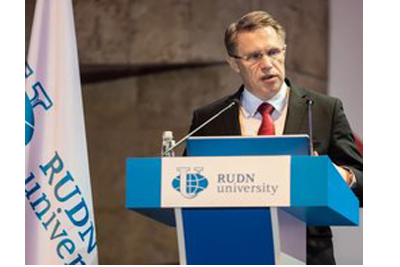
Over the past few years, due to the decision of the World Healthcare Assembly within the 72nd session on 25 May 2019 and the adoption of WHA72.6 resolution on “Global Actions for Patient Safety”, September 17 is marked as World Patient Safety Day.
According to the authors of this initiative, the goal of the World Patient Safety Day is to increase global awareness of patient safety and promote international solidarity in actions aimed at increasing patient safety and reducing harm for patients worldwide, not only in professional communities, but also among patients themselves, their relatives, various organizations representing the interests of patients.
Minister of Healthcare M.A. Murashko gave a public lecture at RUDN University, timed to coincide with the World Patient Safety Day. Minister of Healthcare of the Russian Federation recalled that the safety principles that must be observed at all times and everywhere, are now being integrated into the healthcare system. This is very important: there are 1 billion visits to polyclinics, more than 44 million ambulance calls, nearly 30 million hospitalizations per year in Russia. Medical care, including the use of drug therapy, should be high-quality and safe, for this purpose it is necessary to standardize the main processes, competently and clearly draw up instructions for a wide variety of situations that occur in medical practice. Standardization of basic medical processes, well-defined action algorithms for doctors allow to increase the safety of therapy, speed of assistance and achieve the best results in treatment. But we should not lose the individuality of the patient due to standardization. Healthcare should be patient-oriented, – the Minister is sure.
It is the active position of patients, their involvement in the decision-making process, adherence to the prescribed therapy play a decisive role in the recovery process, form the most successful treatment path, according to Mikhail Murashko.
The Minister of Health dwelt separately on the formation of a culture of medical security – the most competent documents and clear instructions will be useless, if they do not get into a friendly environment, where both the management and staff of the medical institution regularly assess adverse events and the risks of their occurrence, strive for positive change. All personnel of the medical organization should be involved in creation of safety culture. The administration is expected to implement incentive systems, teamwork principles into the day-to-day practice for employees who have reported undesirable events that may lead to patient safety problems.
COVID-19 pandemics pushed pharmaceutical industry to accelerate the development of new medicines. Russia became the first country in the world to register a vaccine against the novel coronavirus infection. Indeed, the use of modern technologies, such as computer modeling, enables faster development of new medicinal products. It is important that these new products are effective and safe.
– A medicinal product that enters the market undergoes a very serious test. Pharmacovigilance collects comprehensive information on a drug, all possible adverse reactions are described in the instructions. But after the authorization procedure of a drug, its studies do not end. It is the duty of physicians to report any unexpected and adverse drug reactions. For the concealment of such information, physicians are responsible to the law. Additional information can lead to changes in the instructions and, eventually, make the drug safer”, the Minister reminded.
At the same time, the causes of adverse events during drug therapy may be very different: genetic insensitivity to individual active substances, features of metabolism, incorrectly selected dosage of the drug, polypragmasia, when a patient with a whole bunch of diseases takes several drugs, which increases the likelihood of side effects.
According to the Minister, the essential condition for improving patient safety is digital transformation of healthcare.
– Using medical profiles of patient digital twins, it is easy to highlight individual risk groups. For example, there is a group of patients for whom vaccination against of certain infections is vital. We won’t be able to call everyone, but modern technologies will allow us to build communication with everyone. Digital transformation of healthcare is a road to patient safety, – Mikhail Murashko is sure.
The Minister reminded medical students that digital technologies are useful for future doctors as well. Thus, the portal of continuing medical education allows medical workers to build an individual training track, increase their competences.
– Personnel is the most expensive resource in healthcare. It may require a year to purchase some medical equipment, building of a polyclinic may take 2-3 years, but the training of healthcare workers sometimes takes a decade, – said the Minister.
As part of this event, on September 16, students of Medical, Pediatric, Dental and Pharmaceutical Faculties of FSBEI HE KSMU of the Ministry of Health of Russia attended an online lecture given by the Head of the Federal Service for Supervision in the Healthcare Sphere A.V. Samoilova, which was hosted by Volgograd State Medical University. At the end of the lecture, a discussion was held on opportunities for the participation of each healthcare worker in the events helping to ensure patient safety. The lecture was attended by more than 1,500 students.
